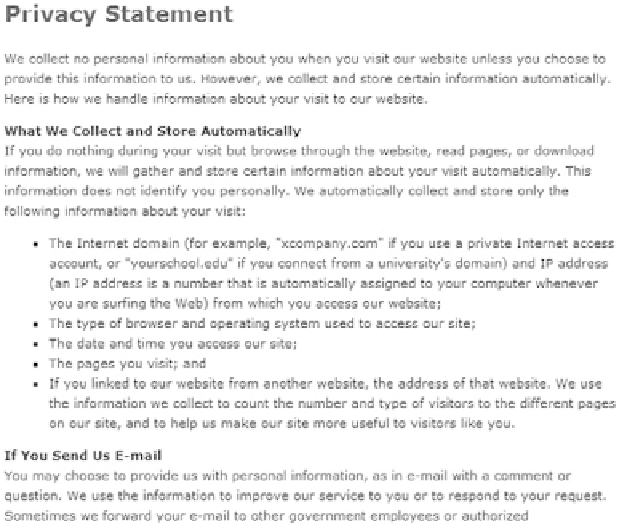HTML and CSS Reference
In-Depth Information
You've just learned how to collect information from your Web site visitors. Do you
think your visitors may want to know how you plan to use the information you collect?
The guidelines that you develop to protect the privacy of your visitors' information is
called a
privacy policy
. Web sites either indicate this policy on the form page itself or
create a separate page that describes the privacy policy (and other company policies). For
example, the order form page at mymoney.gov (
http://mymoney.gov/mymoneyorder.shtml)
indicates the following:
Focus on Ethics
“WE WILL NOT SHARE OR SELL ANY PERSONAL INFORMATION OBTAINED
FROM YOU WITH ANY OTHER ORGANIZATION, UNLESS REQUIRED BY LAW
TO DO SO.”
For a more detailed example of a Web site's privacy notice, visit
http://www.nps.gov/
privacy.htm,
as shown in Figure 9.27. If you browse popular sites such as Amazon.com
or eBay.com you'll find links to their privacy policies (sometimes called a privacy
notice) in the page footer area.
If you've ever filled out a form on a Web site and suddenly received lots of annoying
SPAM, you will most likely agree that you'd rather not have Web sites sharing your
information with others and you'd like to know up front if this will occur. Your visitors
probably feel the same way. Include a privacy notice in your site to inform your visitors
how you plan to use the information they share with you. The Better Business Bureau
provides a sample privacy notice at
http://www.bbbonline.org/privacy/sample_privacy.asp.
Figure 9.27
This privacy notice
describes what
information is
collected




Search WWH ::

Custom Search